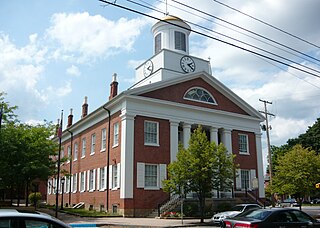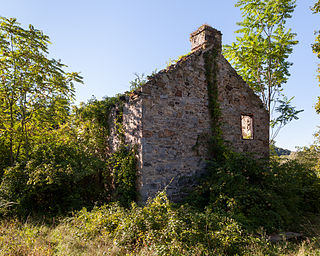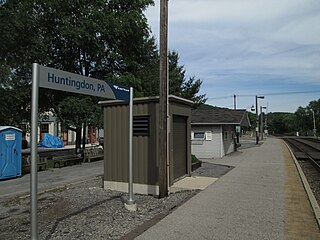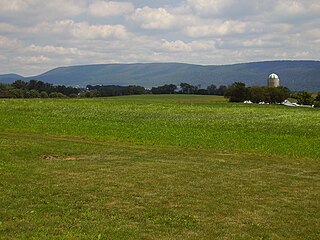
Bedford County is a county in the Commonwealth of Pennsylvania. As of the 2020 census, the population was 47,577. The county seat is Bedford.

Saxton is a borough in Bedford County, Pennsylvania, United States. The population was 722 at the 2020 census.

Penn Township is a township in Huntingdon County, Pennsylvania, United States. The population was 1,086 at the 2020 census. The township includes the village of Hesston and the Seven Points Marina of Raystown Lake.
The Pennsylvania Railroad was an American Class I railroad that was established in 1846 and was headquartered in Philadelphia. Named for the commonwealth it was established in, by 1882, the Pennsylvania Railroad had become the largest railroad, the largest transportation enterprise, and the largest corporation in the world. Its budget was second only to the U.S. government.

The Lehigh and Hudson River Railway (L&HR) was the smallest of the six railroads that were merged into Conrail in 1976. It was a bridge line running northeast–southwest across northwestern New Jersey, connecting the line to the Poughkeepsie Bridge at Maybrook, New York with Easton, Pennsylvania, where it interchanged with various other companies.

The East Broad Top Railroad (EBT) is a 3 ft narrow gauge historic and heritage railroad headquartered in Rockhill Furnace, Pennsylvania.
Railroad electrification in the United States began at the turn of the 20th century and comprised many different systems in many different geographical areas, few of which were connected. Despite this situation, these systems shared a small number of common reasons for electrification.

Huntingdon station is an Amtrak railway station located at 4th and Allegheny Streets in Huntingdon, Pennsylvania, approximately 95 miles northwest of Harrisburg, Pennsylvania and 30 miles east of Altoona, Pennsylvania. The station is located at the south end of the borough, along one of the major streets into Huntingdon, just north of the Juniata River.
The Bellefonte Central Railroad was a shortline connecting Bellefonte and State College, Pennsylvania. Constructed in the late 19th century to haul local iron ore to furnaces in the Bellefonte region, it later hauled freight traffic to Penn State and lime for steelmaking from local quarries. The line to State College was abandoned in 1974, and most of the remaining railroad in 1984, but a small portion is still used by the Nittany and Bald Eagle Railroad.
The Bedford Branch was a rail line owned and operated by the Pennsylvania Railroad in the U.S. state of Pennsylvania.

Tussey Mountain is a stratigraphic ridge in central Pennsylvania, United States, trending east of the Bald Eagle, Brush, Dunning and Evitts Mountain ridges. Its southern foot just crosses the Mason–Dixon line near Flintstone, Maryland, running north 130 km (80 mi) to the Seven Mountains of central Pennsylvania, near Tusseyville, making it one of the longest named ridges in this section of the Ridge-and-valley Appalachians. The ridge line separates Morrison Cove from the Woodcock Valley and Friends Cove from the Black Valley. Tussey Mountain lies in, and the ridge line forms parts of the borders of, Centre, Blair, Bedford and Huntingdon counties.

Standard gauge was favored for railway construction in the United States, although a fairly large narrow-gauge system developed in the Rocky Mountains of Colorado and Utah. Isolated narrow-gauge lines were built in many areas to minimize construction costs for industrial transport or resort access, and some of these lines offered common carrier service. Outside Colorado, these isolated lines evolved into regional narrow-gauge systems in Maine, New York, Pennsylvania, Ohio, Iowa, Hawaii, and Alaska.

Pennsylvania Route 913 is a 17.7-mile-long (28.5 km) state highway located in Bedford, Huntingdon and Fulton Counties in Pennsylvania. The western terminus is at PA 26 in Saxton. The eastern terminus is at PA 655 in Taylor Township.

The Everett Railroad is a shortline and heritage railroad that operates on ex-Pennsylvania Railroad trackage in the Hollidaysburg area of the U.S. state of Pennsylvania. It runs freight trains over two separate lines, one from Brooks Mill and Sproul, and the other, owned by the Morrison's Cove Railroad, from Roaring Spring to Curryville and Martinsburg. The affiliated Hollidaysburg and Roaring Spring Railroad, which the Everett Railroad operates both under contract and via trackage rights, connects the two segments to each other and to the Norfolk Southern Railway (ex-Conrail) in Hollidaysburg. The Everett Railroad name refers to its former location near Everett, abandoned in 1982.
Hesston is a small unincorporated community in Penn Township of Huntingdon County, Pennsylvania. Also located in Hesston is Raystown Lake. Hesston is the home of the Hesston Speedway. Original called Pleasant Grove and Grafton but renamed Hesston.

Broad Top is a plateau located in south-central Pennsylvania. It extends into Huntingdon County to the north, Fulton County to the southeast, and Bedford County to the southwest. It is bounded to the west by Saxton Mountain and Terrace Mountain, and to the east by Sideling Hill. In Bedford County, Harbor Mountain forms the southern boundary. Trough Creek Valley lies between the mountains.

The Tussey Mountain School District is a public school district serving parts of Bedford County, Pennsylvania and Huntingdon County, Pennsylvania. The rural district serves a large number of communities. In Huntingdon County, it encompasses the boroughs of Broad Top City, Dudley, and Coalmont as well as the townships of Carbon, Hopewell, Todd, and Wood. In Bedford County, it serves Coaldale and Saxton Boroughs, as well as Broad Top and Liberty Townships. The district encompasses approximately 173 square miles. According to 2000 federal census data, it serves a resident population of 7,689.
Puttstown is an unincorporated community in Hopewell Township in southwestern Huntingdon County, Pennsylvania, United States. The community is situated along Pennsylvania Route 913, east of Saxton, near the Huntingdon-Bedford County line.
The Pennsylvania State Game Lands Number 73 are Pennsylvania State Game Lands in Bedford, Blair and Huntingdon Counties in Pennsylvania in the United States providing hunting, bird watching, and other activities.
Huntingdon and Broad Top Mountain Railroad and Coal Co. 38 is a preserved 2-8-0 "Consolidation" type steam locomotive. It was built by Baldwin in April 1927 for use on the Huntingdon and Broad Top Mountain Railroad and Coal Company in south central Pennsylvania in the United States, which commonly used the locomotive to pull short-distance freight trains, as well as occasional passenger trains, until the railroad shut down operations in 1954. The locomotive was subsequently acquired by the Rail City Historical Museum in Sandy Creek, New York for static display. In the late 1960s, No. 38 was sold to the Livonia, Avon and Lakeville Railroad in Lakeville, New York, who restored the locomotive to operating condition to pull their excursion trains. In 1977, the locomotive was sold again to the Gettysburg Railroad, which used the locomotive to pull their own tourist trains until 1986, when No. 38 was transferred to the Knox and Kane Railroad to be used there. The locomotive had been removed from service in 1989 for a long-term overhaul that was eventually completed, but it never returned to service for the Knox and Kane. After No. 38 fell victum to an arson-related roundhouse fire in 2008, it was sold at an auction to the Everett Railroad. As of 2022, the Everett Railroad is restoring No. 38 to operating condition for use in excursion service alongside 2-6-0 No. 11.












